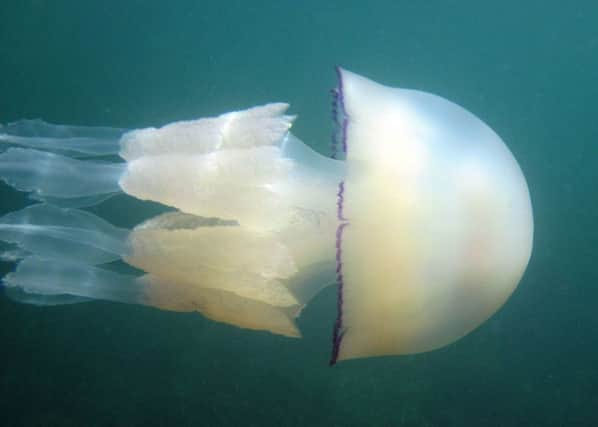Scottish coasts hit by ‘deadly’ jellyfish invasion


Hundreds of thousands of jellyfish have been spotted so far this summer, with numbers looking set to reach record levels for the third year in a row.
There has been a particularly dramatic increase in the number of giant barrel jellyfish washing up around the UK, including Scotland, with the species accounting for 75 per cent of 2015 sightings reported to the Marine Conservation Society (MCS).
Advertisement
Hide AdAdvertisement
Hide AdThis is a significant rise from 40 per cent last year and a major leap from the usual 10 per cent.
Huge numbers of mauve stingers have also been reported in some places, while the rare and dangerous Portuguese Man O’ War has been washing up on beaches on the south-west coast.
Conservationists and scientists are unable to say for sure what is causing the phenomenon, though climate change and human activities have been blamed. But the rise can no longer be ignored, they say.
“Our national jellyfish survey suggests significant recent rises in the numbers of some jellyfish species in UK seas,” said Dr Peter Richardson, biodiversity and fisheries programme manager for the MCS.
“The million-dollar question is why is this happening? At the moment we just don’t know. We know that our seas are changing through climate change, resulting in rising sea temperatures and increased ocean acidification, and we know our seas are also heavily fished.
“At the same time we seem to be witnessing increases in jellyfish around the UK. Is this an anomaly, a coincidence, or are the jellyfish telling us something about fundamental changes in the condition of our seas?”
The survey started in 2003 and involves thousands of members of the public reporting jellyfish encounters. Now the charity is calling for the UK government to back further research into jellyfish populations.
Huge “smacks” of jellyfish are not a new occurrence, with fossils showing similar events took place 500 million years ago. But today they can have serious economic and social consequences.
Advertisement
Hide AdAdvertisement
Hide AdMoon jellyfish blooms forced the shutdown of Torness nuclear power station in 2011 when they clogged up the cooling system, leading the industry to invest in mechanisms to detect jellyfish increases near power plants.
Swarms of mauve stingers have wiped out salmon stocks at fish farms and the same species regularly closes down bathing beaches in the Mediterranean.
The NHS recommends treating stings by removing remaining tentacles and applying ice to reduce pain and inflammation.
Vinegar and other less orthodox therapies are not advised. The NHS website states: “Ignore any advice you may have heard about urinating on the sting.
“It’s unlikely to help and may make the situation worse.”